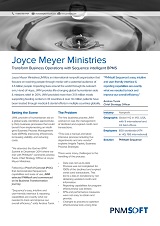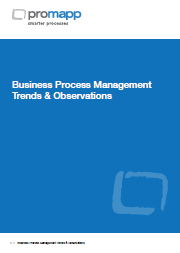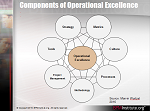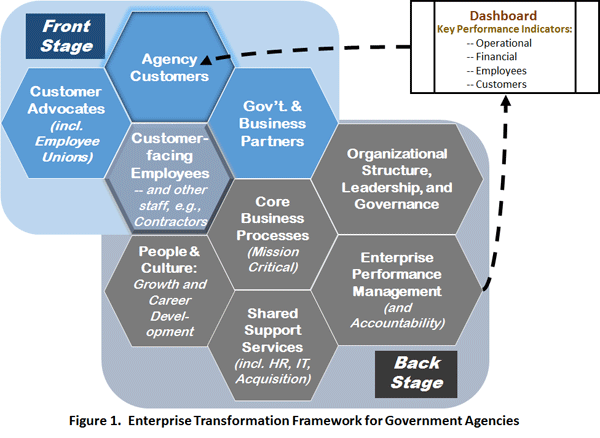Home / Resources
Resources
Discover a Wealth of BPM Knowledge and Expertise at BPMInstitute.org!

Lean Six Sigma and Business Process Management – Better Together
Operational Excellence stresses the application of a variety of principles, systems, and tools toward the sustainable improvement of performance through process improvement.
This management philosophy is based on applying methodologies, such as BPM and Lean Six Sigma. The focus of Operational Excellence goes beyond the traditional event-based model of improvement toward a long-term change in organizational culture.
One of the most powerful ways to improve business performance is combining business process management (BPM) methods with Lean Six Sigma methods. BPM emphasizes process improvements and automation to drive performance improvement, while Lean Six Sigma uses statistical analysis to drive quality improvements. The two methodologies have been considered by times to be mutually exclusive, however, some savvy companies have discovered that combining BPM and Lean Six Sigma can create dramatic results.
BPM Basics

Building a Process Based Organization
Nowadays it seems every mid to large size company is getting clipped at the knees. For example, take the tech industry. Not ten years ago, the industry was dominated by household names including Intel, IBM, Microsoft, Cisco Systems, and Oracle. With the passing of years their core businesses have eroded as upstarts nabbed market share. Today, those maintaining their market position often do so only through the acquisition of their smaller rivals. Their internal growth engines are sputtering if not dead. Why? The issue is not that these tech giants don’t have the resources to compete. Nor is it that they don’t have experienced leaders and talented workforces. They simply are unable to adjust their product portfolios to seize market opportunities. Burdened by traditional corporate structures and business practices, when sparks of innovation flare up they are quickly dowsed by the corporate bureaucracy.

Building Smart Processes with Analytics (via Decisions)
Decisions inject Analytics smartness into Processes, making the processes smarter.
Now that we have automated most routine processing using some programming logic and some basic rules, the next competitive frontier is making these processes adapt dynamically to changing conditions and unforeseen situations – and learning from each such situation. Processes with such sophisticated dynamic behavior are smart processes.
Smart behavior cannot be programmed into the processes without causing unmanageable complexity and catastrophic brittleness. In any case, such ‘programmed’ processes cannot ‘learn’ by themselves. Additional knowledge has to be physically programmed into the process.
So instead of trying to make the process smarter, the focus should be on making the embedded decision smarter – through automation using decision management technologies available today.
Smart Processes are really Smart Decisions

Vision: A Crucial Ingredient of BPM
BPM Institute defines BPM as “The definition, improvement, and management of end-to-end business processes in order to achieve clarity on strategic direction, alignment of resources, and increased discipline in daily operations.” A crucial ingredient in effective implementation of BPM is a common vision that guides the formation of the strategic direction and keeps the resources aligned beyond the initial planning phase and informs the operational decisions that are made every day.

A (Compressed) Day in the Life of a Business Analyst – Part 2
This is the second of a two-part look at a “Day in the Life” of a Business Analyst (BA). During the first half of our “day”, the BA met with principal stakeholders multiple times to understand the problem, document the As Is and To Be, and perform a gap analysis between the two that will form the basis for the solution. The BA speculates that this will involve a combination of changes to people, process, and tools but the next step is to list and prioritize what the solution must include.

Why Big Data Needs BPM
Big data and related topics like the IOT (Internet of Things) are always big topics of interest in large forums. So it was the case in CeBIT 2016, Hannover which I was fortunate enough to attend. There were several talks on Big Data – Digital Disruption was the theme, and there was general consensus that Big data was here to stay and grow phenomenally. People were moving from basic reporting and visualization of data (Data discovery and understanding) to a phase where predictive analytics would rule. This was because of the huge strides made in the fields of Machine Learning and artificial Intelligence. One of the keynote speakers in CeBIT was Professor Nick Bostrom founding Director of the Future of Humanity Institute at Oxford. An extremely impressive speaker and futurist, I was blown away with the vision he had for the future. He spoke passionately that the time for Artificial Intelligence has finally arrived and what it means for society at large.

Ten Steps to Clearer Strategy
The Strategy Execution Process
The strategy execution process provides a structured approach to clarifying, communicating, implementing, and managing strategy. The goal of this process is to ensure the organization focuses on developing high-value capabilities and making investments that optimize value. Most established and successful business architecture practices are deeply engaged in developing their organization’s strategy execution process though few have it completely implemented. Most are attempting to influence strategy from the bottom up.

Case Study: Joyce Meyer Ministries Automates Mission-Critical Processes with BPM
Joyce Meyers Ministries provide life changing global humanitarian aide and missions relief. In 2014, JMM provided more than 31.9 million meals supporting feeding centers in 33 countries, and over 1.6 million patients have been treated through JMM’s medical and dental efforts.
In 2014, JMM identified approximately 30 business processes that could benefit from implementing a business process management suite. The first process they chose to optimize was a process that was very manual and labor-intensive, involving 5 departments, a call center, and external vendors. This process was also critical to securing funds and sustaining operations.
In this webinar, Angela Triplett, Business Process Strategist at JMM, will share the JMM BPM story: from Process Discovery, to selecting a BPM vendor, to the lessons learned & best practice advice on using BPM (both technology & discipline) to address challenges such as:

Conflict Resolution in Process Management
Jocelyne received angry stares from both Keith and Arneil. Jocelyne had wanted to improve their production process to be more nimble and responsive to changing product needs. Both Keith and Arneil were convinced that their operations were fine the way they were. Sales were steady and in a weak economic environment that was an accomplishment. For her part Jocelyne was concerned that they wouldn’t be able to pivot quickly enough to capitalise on changing markets. The discussion went round and round until tempers flared and the business unit’s ability to function as a team crumbled. They were stuck at the analysis phase as some members of the team didn’t recognise that there was a need to improve the process.

Business Architect in a Big Data Era
Cloud, big data, and analytics are disruptive technologies that are affecting almost every enterprise across multiple industries. Companies are trying their best to leverage these new capabilities to gain advantage in a highly competitive market place. Companies that do not evolve to leverage these capabilities may be left behind and could even become unviable in the near future. Ubiquitous data from consumer smartphone usage can provide valuable insights for companies, but ubiquitous data comes with set of challenges viz., storing, managing, and analyzing the large volumes of data. Cloud and big data technologies are positioned as the panacea to leverage and analyze ubiquitous consumer data.

Managing By Process: What Does It Really Mean?
Ask senior BPM professionals what “managing by process” means and you will receive a variety of responses.
“It becomes a strait jacket that inhibits improvement and innovation.”
“Most organizations don’t understand managing by process…they approach it in a vacuum, disconnected from the most important goals of a company and other key practices that support a company’s strategy.”
Yet, those same experts voice common threads of agreement.
Managing by process is about:
Meet the Author: David Hamme, Customer Focused Process Innovation
Author of Customer Focused Process Innovation: Linking Strategic Intent to Everyday Execution
For any organization to prosper, its leadership must drive bottom line results, expand the product offerings, and identify opportunities to better strategically position the organization. But all too often they look to trendy business practices or copy the competition. They don’t know the answers to basic questions: How do things really work and fit together in this organization? What does the customer really want from us? Who really does what and where do I fit in? How can I move the ball forward? Without these answers, the organization’s innovation capabilities are limited.
Customer Focused Process Innovation: Linking Strategic Intent to Everyday Execution
For any organization to prosper, its leadership must drive bottom line results, expand the product offerings, and identify opportunities to better strategically position the organization. But all too often they look to trendy business practices or copy the competition. They don’t know the answers to basic questions: How do things really work and fit together in this organization? What does the customer really want from us? Who really does what and where do I fit in? How can I move the ball forward? Without these answers, the organization’s innovation capabilities are limited.
Enter, business innovation expert David Hamme. In his book, CUSTOMER FOCUSED PROCESS INNOVATION, Hamme provides the framework to transform organizations into Process Focused Enterprises—ones in which organizational silos, command-and-control management, guesswork, and information inadequacies cease to exist.

A (Compressed) Day in the Life of a Business Analyst – Part 1
This is the first of a two-part look at a “Day in the Life” of a Business Analyst (BA). It’s broken into hours as a simple way to illustrate the myriad duties and skills that a BA needs to have, but in real life the process described below would take weeks, months, or possibly years, depending on the size of the effort. And, as every BA knows, there’s no such thing as a typical day – or even a standard job description. We’ll look here at the phases that every effort has, and tools that every BA needs.

Business Process Management Trends & Observations
Business Process Management Research Report:
Check out the future of BPM and see how your organization stacks up.
Research conducted by global market research company, TNS Global, shows that while BPM is delivering key benefits in both the public and private sectors, a large number of organizations still struggle to keep processes documented or up to date.
Download this BPM research whitepaper to see how your organization compares and get valuable insights into future BPM investment benchmarks, the level of BPM resourcing within organizations, common barriers to process improvement and the role BPM plays in helping businesses achieve their organizational goals.

Making the case for OpEx and BPM
The integration of Operational Excellence, which relies on a proven, systematic set of tools in Lean Six Sigma, and Business Process Management (BPM), which relies on a systemic view and a technology enabled approach is likely to create greater value for both customers and the company. The integration and consolidation of these two approaches to process improvement will not only identify and eliminate waste, it will also align and better utilize information systems, promote cross departmental collaboration and keep the customer front and center throughout.

An Introduction to Operational Excellence
Operational Excellence is not easy to define. Some descriptions are too broad. Others are so narrow that the ultimate definition seems too focused in scope. Often, we end up with definitions that seem plausible in an academic sense, such as “Being world class,” “Being the best globally,” or, “Excellence in everything we do,” but these are difficult to translate into specific practices.
To properly define Operational Excellence, there is value in looking at the evolution of the term.
In “The Discipline of Market Leaders – Choose your Customers, Narrow your Focus, Dominate your Market“, Michael Treacy and Fred Wiersema described three distinct value propositions or disciplines an organization could choose to compete in their market or industry – Operational Excellence, Product Leadership, and Customer Intimacy.

When Should Change Management Start?
So often I see organizational change management as a part of the implementation plan for putting the recommendations and new design of a Business Process Improvement project (BPI) into operation in a company. It should be there, but it needs to start sooo much earlier. In fact it needs to start with the first phase of a BPI project- namely in developing the charter and doing Process Discovery and Modeling.

Amplifying BPM with Customer Experience and Design Thinking
In the modern Digital world, Customer Experience is a critical factor for success in BPM. Organizations can apply Design Thinking framework to map the right emotional innovation factors and succeed in the BPM transformation.
Amplifying BPM with Customer Experience and Design Thinking

Managing Enterprise Transformation in Government
“Culture does not change because we desire to change it. Culture changes when the organization is transformed; the culture reflects the realities of people working together every day.” Frances Hesselbein – President of the Frances Hesselbein Leadership Institute
Effective use of a transformation framework, such as the one illustrated in Figure 1, is a hallmark of successful organizations and an essential means to achieving operational and technology environments that maximize institutional mission performance and outcomes. Among other things, this includes realizing cost savings through consolidation and reuse of shared services and elimination of antiquated and redundant mission operations, enhancing information sharing through data standardization and system integration, and optimizing service delivery through streamlining and normalization of business processes and mission operations.













